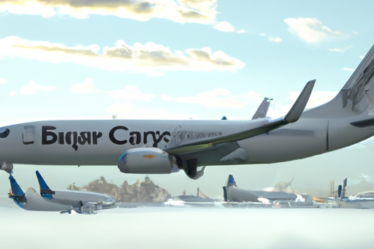Exploring the Factors Behind the Airline Industry’s Record-High RPK and PLF
The airline industry has recently achieved record-high revenue passenger kilometers (RPK) and passenger load factor (PLF). This is an impressive feat for an industry that has faced numerous challenges in recent years. In this article, we will explore the factors behind the airline industry’s success in achieving these record-high numbers.
One of the key factors contributing to the airline industry’s record-high RPK and PLF is the increasing demand for air travel. As the global economy continues to grow, more people are choosing to travel by air for both business and leisure purposes. This has led to a significant increase in the number of passengers flying on airlines worldwide.
Another factor driving the industry’s success is the improved efficiency of airlines. Over the years, airlines have made significant investments in technology and infrastructure to streamline their operations. This has resulted in shorter turnaround times, improved on-time performance, and increased overall efficiency. These improvements have not only benefited the airlines themselves but also the passengers, who can now enjoy a smoother and more seamless travel experience.
Furthermore, the airline industry has benefited from the increasing affordability of air travel. With the rise of low-cost carriers and the availability of discounted fares, air travel has become more accessible to a larger segment of the population. This has led to a surge in demand for air travel, particularly among budget-conscious travelers.
In addition to these factors, the airline industry has also benefited from the growing trend of international travel. As more people are choosing to explore new destinations and experience different cultures, the demand for international flights has soared. This has prompted airlines to expand their route networks and offer more flights to popular international destinations.
Moreover, the airline industry has been successful in adapting to changing consumer preferences. Today’s travelers are looking for more than just a means of transportation – they want a personalized and enjoyable travel experience. Airlines have responded to this demand by offering a wide range of in-flight amenities, such as Wi-Fi, entertainment systems, and comfortable seating options. Additionally, airlines have invested in loyalty programs and frequent flyer benefits to incentivize repeat business.
Lastly, the airline industry has benefited from the increasing focus on sustainability and environmental responsibility. Airlines have made significant efforts to reduce their carbon footprint by investing in more fuel-efficient aircraft, implementing sustainable practices, and offsetting carbon emissions. This commitment to sustainability has not only attracted environmentally conscious travelers but has also helped the industry improve its overall efficiency and reduce operating costs.
In conclusion, the airline industry’s record-high RPK and PLF can be attributed to a combination of factors. The increasing demand for air travel, improved efficiency, affordability, international travel trends, consumer preferences, and sustainability efforts have all played a role in the industry’s success. As the industry continues to evolve and adapt to changing market dynamics, it is likely that we will see further growth and achievements in the years to come.
The Implications of the Airline Industry’s Achievements in RPK and PLF
The airline industry has recently achieved record-high figures in two key performance indicators: Revenue Passenger Kilometers (RPK) and Passenger Load Factor (PLF). These achievements have significant implications for both the industry and travelers alike.
Firstly, let’s delve into what RPK and PLF actually mean. RPK is a measure of the total number of kilometers traveled by paying passengers on an airline. It is calculated by multiplying the number of paying passengers by the distance traveled. On the other hand, PLF is a measure of how full an airline’s planes are. It is calculated by dividing the number of revenue passenger kilometers by the available seat kilometers (ASK), and then multiplying by 100 to get a percentage.
The fact that the airline industry has achieved record-high figures in both RPK and PLF is a testament to its growth and success. It indicates that more people are choosing to fly, and that airlines are effectively filling their planes. This is great news for the industry, as it means increased revenue and profitability.
One of the implications of these achievements is that airlines are likely to continue investing in expanding their fleets and routes. With more people flying and planes being filled to capacity, there is a growing demand for air travel. Airlines will want to capitalize on this demand by offering more flights to popular destinations and exploring new markets. This expansion will not only benefit the industry but also provide travelers with more options and potentially lower fares.
Another implication of the industry’s achievements in RPK and PLF is the need for improved infrastructure and technology. As more people choose to fly, airports will need to handle larger volumes of passengers and planes. This will require investments in airport expansion, runway upgrades, and advanced technologies to ensure smooth operations and minimize delays. Additionally, airlines will need to invest in modern aircraft with higher capacity and fuel efficiency to meet the growing demand while reducing their environmental impact.
Furthermore, the achievements in RPK and PLF highlight the importance of customer satisfaction and loyalty. Airlines that consistently provide a positive travel experience, including comfortable seats, friendly service, and on-time departures, are more likely to attract and retain customers. This means that airlines will need to continue investing in improving their services and ensuring a seamless travel experience for passengers. From online check-in to in-flight entertainment options, airlines will need to stay ahead of the curve to meet the expectations of today’s tech-savvy and demanding travelers.
Lastly, the achievements in RPK and PLF also have implications for the environment. As more people choose to fly, the carbon footprint of the airline industry increases. This puts pressure on airlines to find ways to reduce their emissions and operate more sustainably. From investing in biofuels to implementing more efficient flight routes, airlines are actively working towards reducing their environmental impact. Achieving record-high figures in RPK and PLF serves as a reminder that sustainability should be a priority for the industry moving forward.
In conclusion, the airline industry’s achievements in RPK and PLF have far-reaching implications. From expanding fleets and routes to improving infrastructure and technology, the industry is poised for growth. However, it also faces challenges in meeting customer expectations and reducing its environmental impact. By addressing these challenges, the industry can continue to thrive while providing travelers with a positive and sustainable travel experience.
Analyzing the Future Outlook for the Airline Industry’s RPK and PLF Growth
The airline industry has been experiencing significant growth in recent years, with record-high revenue passenger kilometers (RPK) and passenger load factor (PLF). RPK measures the total number of kilometers traveled by paying passengers, while PLF represents the percentage of available seats that are filled with passengers. These two metrics are crucial in analyzing the future outlook for the airline industry’s growth.
One of the main factors contributing to the industry’s success is the increasing demand for air travel. As the global economy continues to grow, more people are choosing to travel by air for both business and leisure purposes. This trend is expected to continue in the coming years, driving further growth in RPK and PLF.
Furthermore, the rise of low-cost carriers has made air travel more accessible to a wider range of consumers. These airlines offer affordable fares, attracting budget-conscious travelers who may have previously opted for alternative modes of transportation. As a result, the number of passengers flying on low-cost carriers has been steadily increasing, contributing to the overall growth in RPK and PLF.
Another factor that has contributed to the industry’s success is the improvement in airline efficiency. Airlines have been investing in new technologies and processes to streamline operations and reduce costs. This has allowed them to offer competitive fares while maintaining profitability. Additionally, advancements in aircraft design have led to more fuel-efficient planes, reducing operating costs and environmental impact.
The growth in RPK and PLF has also been driven by the expansion of airline networks. Airlines are constantly adding new routes and increasing flight frequencies to meet the growing demand. This has opened up new travel opportunities for passengers and increased connectivity between different regions. As a result, more people are choosing air travel as their preferred mode of transportation, further boosting RPK and PLF.
Looking ahead, the future outlook for the airline industry’s RPK and PLF growth remains positive. Economic growth is expected to continue, driving increased demand for air travel. Additionally, the ongoing expansion of low-cost carriers and the continuous improvement in airline efficiency will contribute to the industry’s success.
However, there are also challenges that the industry must address to sustain this growth. One of the main concerns is the impact of climate change and the need for airlines to reduce their carbon footprint. Airlines are increasingly investing in sustainable practices and exploring alternative fuels to mitigate their environmental impact. This will be crucial in ensuring the long-term viability of the industry.
Furthermore, geopolitical uncertainties and economic fluctuations can also impact the industry’s growth. Trade tensions, political instability, and economic downturns can all affect passenger demand and travel patterns. Airlines must remain agile and adaptable to navigate these challenges and continue to provide reliable and efficient services to their customers.
In conclusion, the airline industry has achieved record-high RPK and PLF, driven by increasing demand, the rise of low-cost carriers, improved efficiency, and network expansion. The future outlook for the industry’s growth remains positive, with economic growth and ongoing advancements in technology and sustainability driving further expansion. However, challenges such as climate change and geopolitical uncertainties must be addressed to ensure the industry’s long-term success. Overall, the airline industry is poised for continued growth and success in the coming years.


